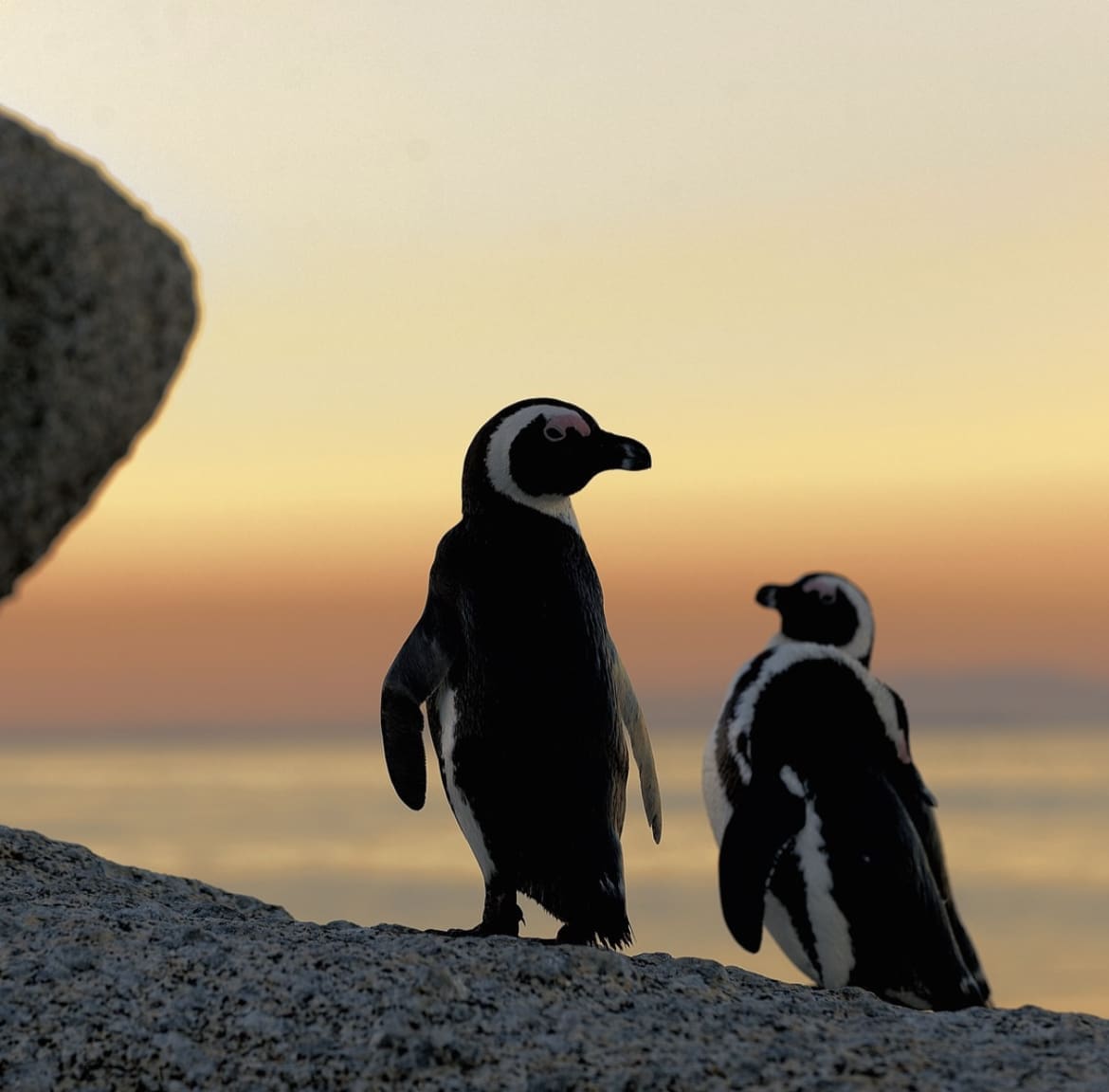Alright, let’s dive into the world of the African Penguin, but not in the way you’d expect. No dry, textbook-style monologue here. Instead, imagine we’re exploring the life of these tuxedoed swimmers in a way that’ll make you want to book the next flight to South Africa, or at least seriously consider adopting one (Spoiler: you can’t, but it’s a nice thought).
Picture this: a penguin, but not just any penguin. This one’s sunbathing on a picturesque beach in South Africa, far from the icy landscapes you’d normally associate with these birds.
Welcome to the world of the African Penguin, a species that’s as unique as it is adorable. We’re talking about a bird that’s mastered the art of living life on the edge—of Africa, that is.
And while they might not be winning any marathons on land, they’re absolute torpedoes in the water.
What is the African Penguin?
The African Penguin (Spheniscus demersus), also affectionately known as the “jackass” penguin for its donkey-like bray, is a species that’s breaking all the penguin stereotypes. They don’t live in Antarctica and they certainly don’t waddle around icebergs. Instead, these birds call the rocky coastlines and islands of southern Africa their home, from Namibia down to South Africa.
They’re about as beachy as penguins get, sporting a sleek black and white coat that’s not just for looks—it’s a sophisticated tuxedo that helps them navigate their seaside world. With a diet that’s a seafood lover’s dream, consisting mainly of fish and the occasional side of squid, they’re living the oceanic lifestyle to the fullest.
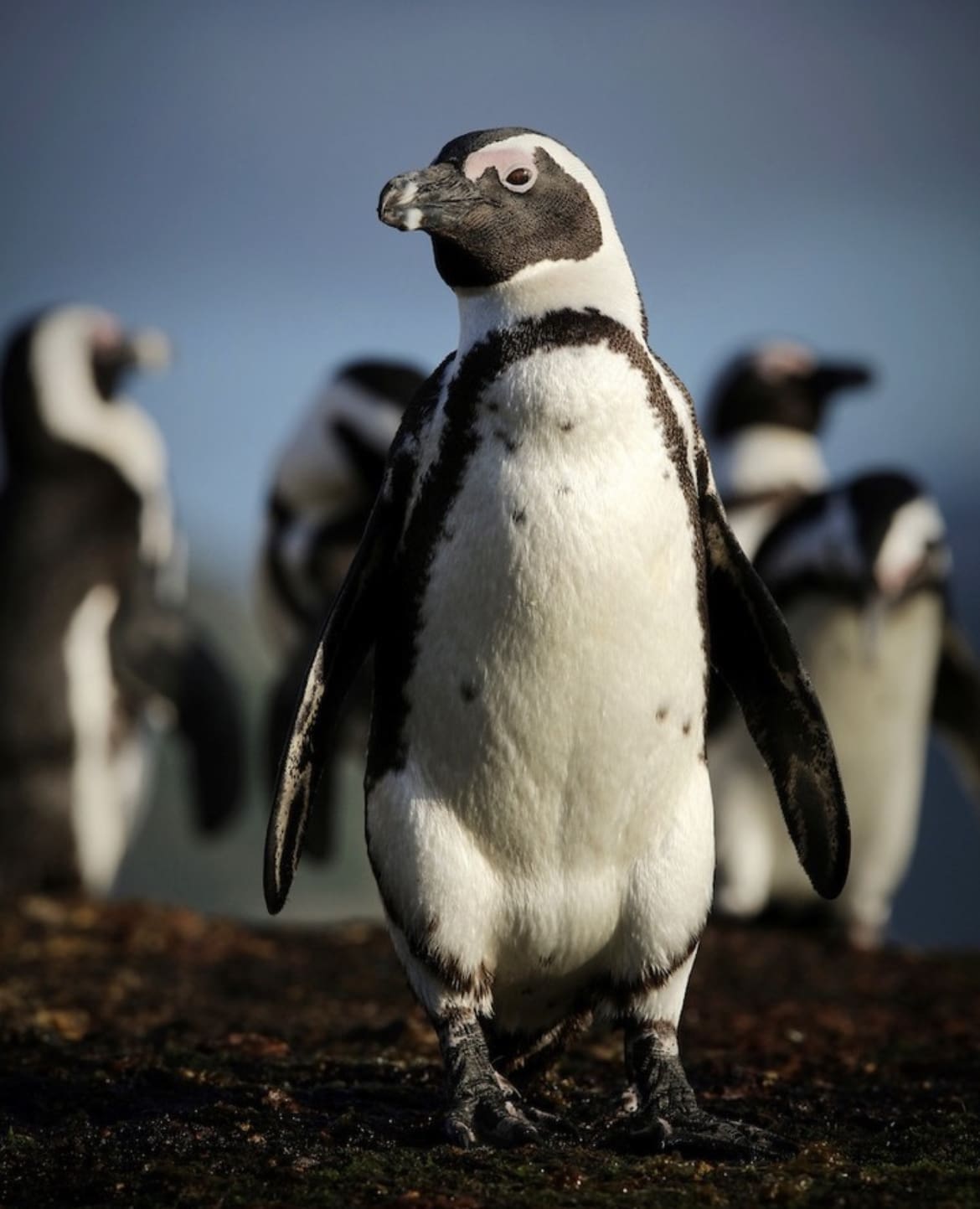
African Penguin vs. Emperor Penguin
Now, let’s pit our African Penguin against the heavyweight champion of the penguin world, the Emperor Penguin. It’s like comparing a city slicker to a rugged outdoorsman. The Emperor Penguin is the tall, brooding type that thrives in the harshest cold you can imagine, while the African Penguin is more of the beach bum variety, soaking up the sun and enjoying milder climates.
Size-wise, the African Penguin is the underdog, standing only about 24 to 28 inches tall and weighing in at a mere 5 to 11 pounds. Meanwhile, the Emperor towers over at nearly 4 feet and tips the scales at up to 88 pounds. But what the African Penguin lacks in size, it makes up for in agility, both in water and on land. Living in temperate climates means these penguins have to be versatile, navigating both the surf of their oceanic buffets and the turf of their shoreline abodes.

What Do African Penguins Look Like?
If the African Penguin had a LinkedIn profile, its picture would be pretty dapper. These penguins sport a slick black-and-white plumage that’s not just for show. The white belly and darker back are all about “counter-shading,” a clever camouflage that keeps them incognito from both airborne predators and the seafood they’re aiming to snag. Their bodies are streamlined for swimming, with a set of flippers that make them look like they’re perpetually ready for a formal dinner under the sea.
But it’s not just their tuxedo that makes them stand out at the party. They’ve got distinctive pink glands above their eyes, which are all about keeping cool under the African sun. The hotter they get, the more blood is sent to these glands to be cooled by the air, a nifty natural AC system. Plus, those black spots you see? They’re as unique as fingerprints, giving each penguin its own signature look.
How Big Are African Penguins?
When it comes to size, African Penguins might not be the giants of the penguin world, but they pack a lot of personality into a compact frame. Standing about 24 to 28 inches tall and weighing in at a feathery 5 to 11 pounds, they’re the perfect size for darting through the water and navigating the rocky shores they call home.
Think of them as the agile point guards of the penguin basketball team—small but mighty, with a turn of speed that surprises their opponents and delights their fans.
African Penguin Skin
Now, let’s talk about what’s under those classy tuxedos: penguin skin. You might not think much about what lies beneath those feathers, but African Penguin skin is all about keeping these birds cool in the heat and snug in the cold.
Their skin has to handle the African sun, after all, which is no small feat. It’s tough, yet sensitive, with a layer of blubber underneath for insulation. This is their secret to staying active during the day, whether they’re lounging on the beach or diving for dinner.
So, while they might not need sunscreen, their skin is a marvel of natural engineering, designed to withstand everything their environment throws at them.
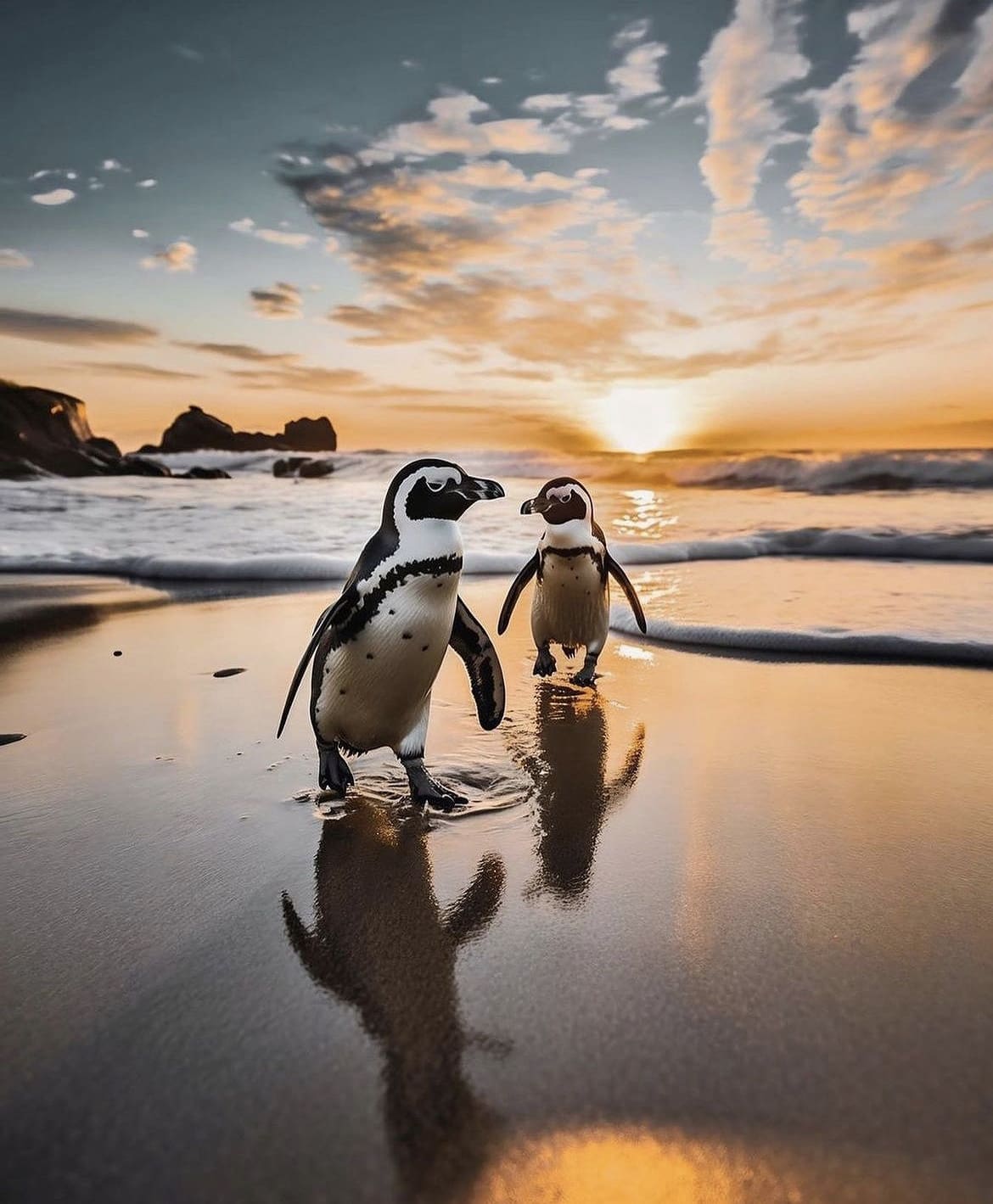
African Penguin Wings
What about those wings? If you’re picturing the African Penguin taking flight, I hate to break it to you, but these wings aren’t for soaring through the skies. Instead, they’re evolved into powerful flippers, making these birds masters of the marine world.
These are no delicate appendages; they’re muscular, strong, and perfectly shaped for slicing through water at speeds that would make a seal envious. Watching an African Penguin in the ocean is like watching a professional swimmer—every movement is precise, powerful, and purposeful.
They might waddle with a bit of a comic shuffle on land, but in the water, they’re as graceful as any dancer, turning on a dime and diving deep with ease.
African Penguin Feet
When it comes to getting around, the African Penguin’s feet are where the rubber hits the road—or, more accurately, where the flipper meets the sand. These aren’t your average bird feet; they’re strong, webbed, and built for both swimming and walking.
In the water, they act like rudders, steering and propelling the penguin with impressive agility. On land, they might look a bit clumsy, but they’re actually quite adept at navigating rocky terrains and sandy beaches. The African Penguin’s feet are also a key part of their thermoregulation system.
In the blazing heat, they can control blood flow to their feet to release body heat, keeping them cool while they sunbathe or waddle around their colonies.
African Penguin Colouration
Now, let’s talk style. The African Penguin’s colouration isn’t just about looking sharp. Their distinctive black and white plumage is a masterclass in evolutionary design, offering camouflage from predators in a phenomenon known as counter-shading.
From above, their dark backs blend in with the murky depths of the ocean, making it hard for aerial predators to spot them. From below, their white bellies match the brightness of the sunlit water surface, keeping them hidden from underwater threats. But it’s not all about defense; their pattern also plays a role in social signaling and mate selection, with those crisp, clear lines and spots being a sign of health and good genetics.
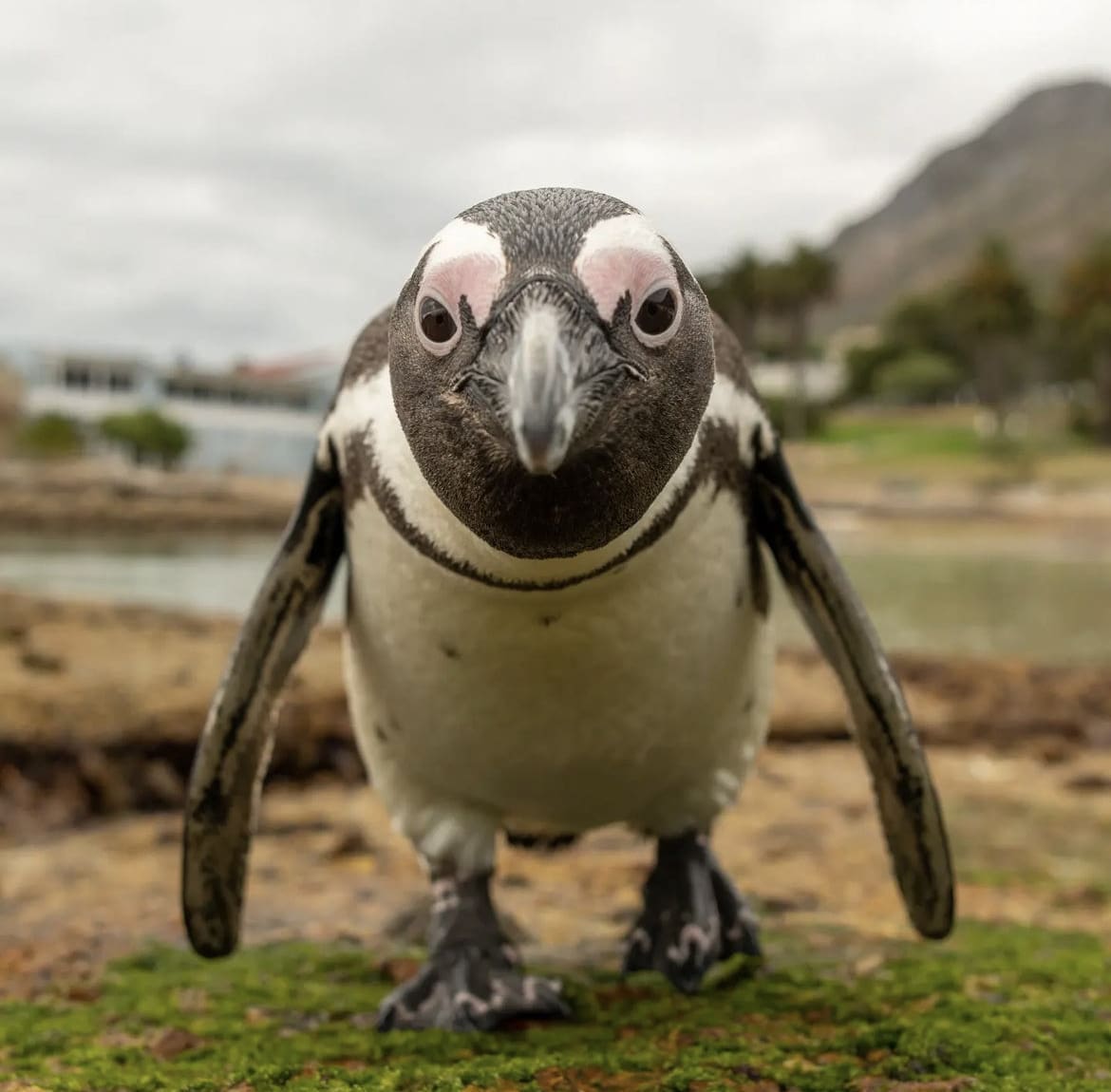
What Do African Penguins Eat?
Dive into the diet of the African Penguin, and you’re in for a seafood feast. These birds are piscivorous, meaning fish make up the bulk of their diet, with a side of squid and the occasional crustacean for good measure.
They’re not picky eaters, but they do have their favorites, like anchovies, sardines, and small shoaling fish. Hunting is a daily challenge that requires speed, agility, and teamwork. African Penguins can dive up to 400 feet in pursuit of their prey, using their sharp beak to snatch up fish with precision. It’s a tough life out in the open sea, but these penguins are equipped with the skills and appetite to make the most of their maritime buffet.
African Penguin Social Structure
African Penguins are the epitome of community living. They’re not loners but thrive within the bustling life of their colonies. These colonies serve as crucial hubs for mating, nesting, and raising their young, but also as a defense mechanism against predators and harsh environmental conditions. Within these communities, African Penguins maintain strong social bonds, often seen preening each other to strengthen relationships and keep their feathers in top condition.
Communication is key in penguin society. They have a range of vocal and visual signals to express everything from territorial claims to courtship intentions. The iconic “braying” sound, reminiscent of a donkey’s call, is not just for kicks; it plays a pivotal role in mate recognition and bonding. This social structure is not just about survival; it’s about creating a life, a testament to the power of cooperation and social connections in the wild.
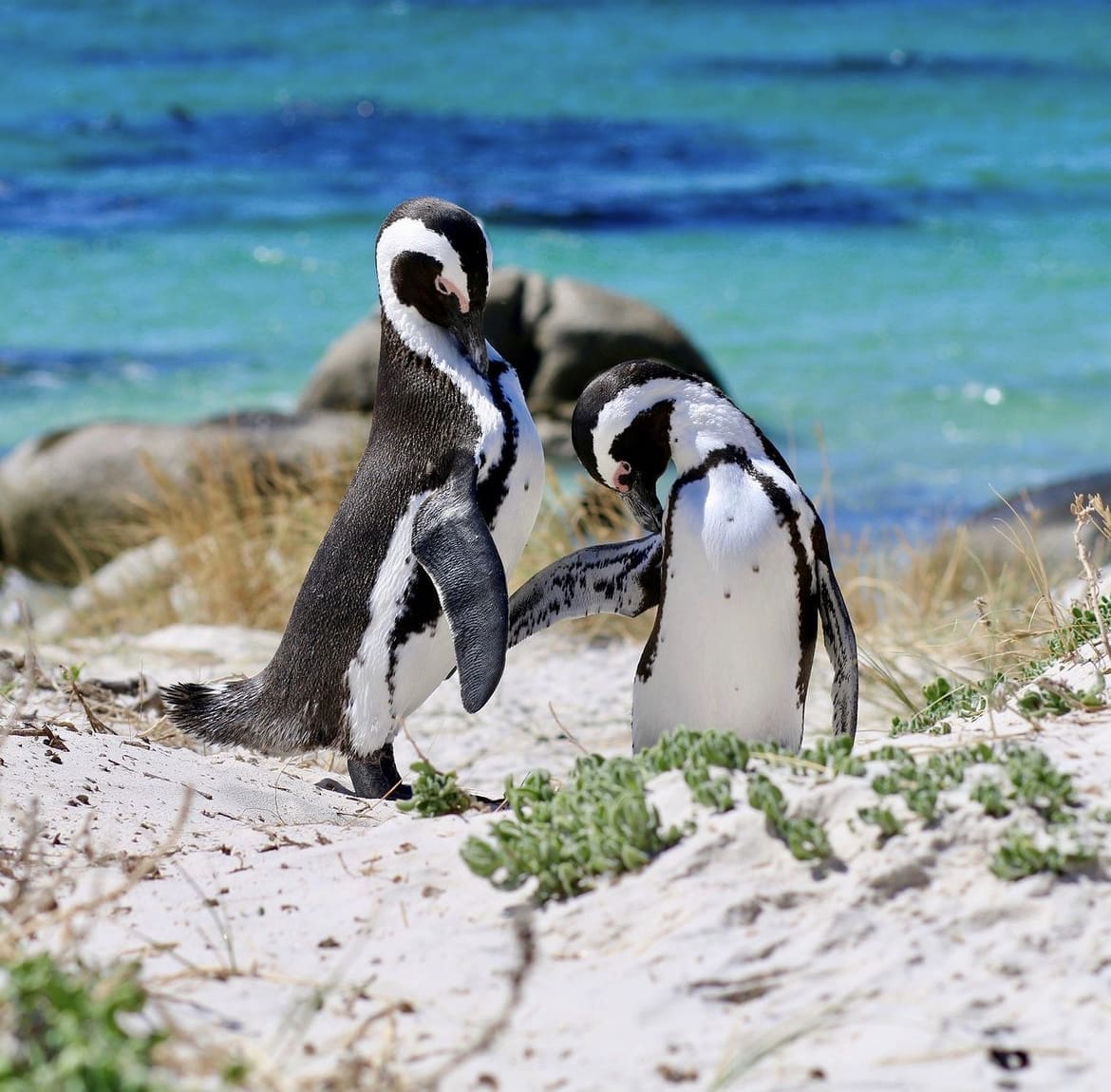
How Do African Penguins Reproduce?
When it comes to romance, African Penguins are old-fashioned. They are monogamous, often mating for life, and have a sweet way of solidifying their bonds through mutual preening and vocal duets. Breeding can happen at any time of the year, but it’s most common during periods when food is abundant. The choice of nesting sites is critical; they prefer sandy or guano-covered terrain where they can dig burrows to protect their eggs from the sun and predators.
A typical clutch consists of two eggs, with both parents sharing incubation duties over a period of about 38 to 42 days. This teamwork extends to feeding and protecting the chicks once they hatch, showcasing a level of parental investment that’s heartwarming. The chicks are born with a fluffy down, which they’ll shed for their juvenile plumage before taking on the sleek, waterproof feathers of adulthood.
How Long Do African Penguins Live?
In the wild, African Penguins can live up to 10 to 15 years, though this is increasingly rare due to the myriad of challenges they face, from predators to human-induced threats. In captivity, where dangers are minimized, they can live up to 20 years or more, showcasing the impact of environmental pressures on their lifespan.
Their survival from hatchling to adult is fraught with hazards, yet each year they manage to survive is a testament to their resilience. Predation by seals in the water and various land animals, along with human disturbances, make their journey to adulthood an epic saga of survival. It’s a life marked by beauty and struggle, encapsulating the delicate balance of nature.
Are African Penguins Aggressive?
At first glance, African Penguins might seem like the life of the coastal party, all dressed up and ready for a gala in their sleek tuxedos. But when it comes down to it, they have a feisty side, especially when they feel threatened or when their territory is at stake. They’re not starting fights with every shadow that passes, but they’re definitely not backing down from protecting what’s theirs.
During breeding season, this feistiness is dialed up a notch. African Penguins become quite protective of their nests and their partners, ready to peck or use their flippers to fend off intruders or overly curious neighbors. However, this aggression is mostly reserved for those moments of tension. Outside of these scenarios, they’re pretty sociable creatures, mingling and communicating within their colonies.

Are African Penguins Territorial?
Absolutely, African Penguins take their personal space very seriously, especially when it comes to nesting sites and during the breeding season. Each pair claims a territory, which they’ll defend vehemently against other penguin couples or predators. This territorial behavior is crucial for their survival, ensuring they have a safe spot to lay their eggs and rear their chicks.
Their territories aren’t expansive, given the dense living conditions in their colonies, but within their chosen patch, they’re the kings and queens of the castle. This behavior underscores the importance of location in the harsh, competitive environment they inhabit. It’s not just about having a piece of the beach; it’s about securing a future for their offspring.
Where Do African Penguins Live?
Speaking of real estate, African Penguins have a pretty specific checklist for their ideal home. They’re found exclusively along the southwestern coast of Africa, stretching from Namibia down through South Africa. Their habitats are as picturesque as they are practical, comprising rocky shorelines, beaches, and islands that provide ample nesting sites and quick access to their feeding grounds in the cold waters of the Benguela Current.
Places like Boulders Beach near Cape Town have become famous for their African Penguin populations, where humans can observe these birds in their natural habitat, coexisting respectfully at a distance. These areas offer everything the penguins need: sandy burrows for nesting, a supply of fish from the surrounding waters, and a temperate climate that doesn’t swing too extremely in any direction. It’s the perfect setup for a species that’s adapted to balance life on land and in the sea.
Penguins in Cape Town
Cape Town, South Africa, is not just a hub for tourists seeking the beauty of Table Mountain or the historical significance of Robben Island. It’s also a sanctuary for one of the most charming residents: the African Penguin. Specifically, Boulders Beach has become synonymous with penguin viewing, offering a rare opportunity to see these birds up close in their natural habitat, all within the unique setting of a bustling city’s proximity.
This juxtaposition of urban life and wild nature highlights the delicate balance required to protect these creatures while allowing humans to marvel at their beauty. The success story of Boulders Beach and its penguin colony is a testament to conservation efforts that aim to provide safe breeding and living conditions for the African Penguins, ensuring their survival amid growing urban encroachment.
How Many African Penguins Are There in the Wild?
Despite being a beloved symbol of wildlife conservation, African Penguins face a daunting reality. Their numbers have been dwindling at an alarming rate, pushing them closer to the brink of extinction. As of the last few decades, the population has decreased significantly, with estimates suggesting a decline of over 50% in the last 60 years. Today, the total number of African Penguins is estimated to be just under 50,000 breeding pairs, a stark contrast to the early 20th century when they numbered in the millions.
This decline is attributed to a combination of factors, including overfishing, which depletes their food sources, oil spills and pollution, which threaten their health and the cleanliness of their habitat, and climate change, which disrupts their breeding patterns and food availability. The stark numbers serve as a clarion call for intensified conservation efforts to prevent the loss of this iconic species.
Are African Penguins Endangered?
The stark reality is yes, African Penguins are classified as endangered by the International Union for Conservation of Nature (IUCN). This status is a reflection of the rapid decline in their population numbers and the persistent threats that jeopardize their survival. Being labeled as endangered is a crucial step in drawing global attention to their plight, mobilizing resources, and implementing conservation strategies aimed at reversing the trend.
The conservation efforts are multifaceted, involving habitat restoration, establishing marine protected areas to safeguard feeding grounds, rehabilitation for oiled and injured birds, and research to better understand their needs and threats. The goal is not just to halt their decline but to create a sustainable environment where African Penguins can thrive for generations to come.
Threats to African Penguins in the Wild
The life of an African Penguin is fraught with challenges, both natural and man-made. Predation by seals and sharks in the ocean and various land predators, such as mongooses and genets, poses a significant risk, especially to the young and the weak. However, it’s the human-induced threats that have escalated their march towards endangerment.
Overfishing has severely depleted their primary food sources, forcing penguins to travel further and expend more energy to find nourishment. Oil spills and pollution not only contaminate their pristine habitat but also compromise their health and the insulating quality of their feathers. Climate change exacerbates these issues, altering ocean currents and fish distributions, making it harder for penguins to feed themselves and their chicks.
Where to See African Penguins
For those eager to witness the charm of African Penguins in their natural setting, there are a few key spots renowned for their accessibility and the opportunity they provide for close encounters. Boulders Beach in Simon’s Town, just outside Cape Town, is perhaps the most famous, offering visitors the chance to observe penguins at close range while respecting their space. Other notable locations include Robben Island, Betty’s Bay, and some parts of the Namibian coastline.
When visiting these areas, it’s crucial to follow guidelines and respect barriers to minimize disturbance to the penguins and their habitat. Responsible tourism supports conservation efforts by raising awareness and funding, but it requires an ethical approach to wildlife interaction.
Tips for Spotting African Penguins
Spotting these adorable creatures in the wild can be an exhilarating experience. Early morning or late afternoon, when penguins are most active on land, offers the best viewing opportunities. Look for their distinctive tracks in the sand to find their pathways between the sea and nesting areas. Being patient and quiet can also reward you with more natural behaviors as penguins are less likely to be disturbed by your presence.
Facts about The African Penguin
- African Penguins can swim at speeds of up to 20 km/h (12 mph).
- They have a specialized gland behind their eyes to filter salt from seawater, allowing them to drink it.
- Each penguin has a unique pattern of spots on its belly, similar to human fingerprints.
- Despite their adorable appearance, they’re known for their loud, donkey-like bray, especially during mating season.
Myths about The African Penguin
- Myth: Penguins mate for life. Reality: While they’re mostly monogamous, partnerships can change if breeding isn’t successful.
- Myth: Penguins can only live in cold climates. Reality: African Penguins thrive in the temperate climates of southern Africa.
- Myth: Penguins have no natural predators. Reality: They face threats from seals, sharks, and occasionally, large birds of prey.

